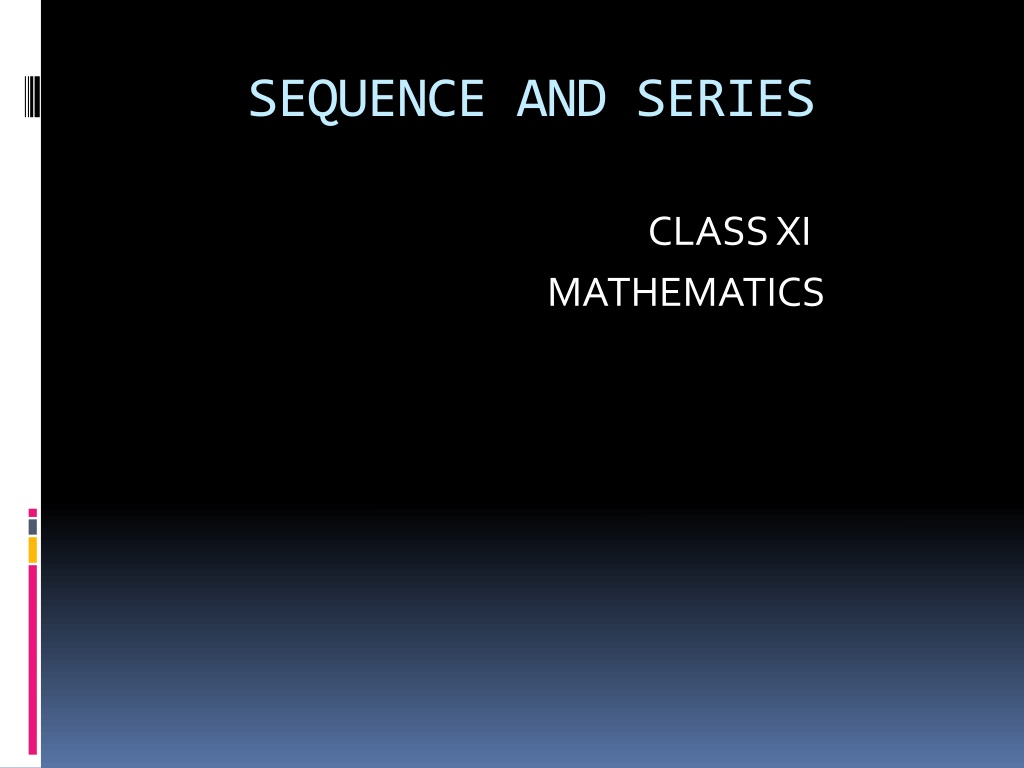Understanding Sequences and Series in Mathematics
Sequences and series are fundamental concepts in mathematics, with sequences consisting of terms denoted as a1, a2, a3, ... and series involving the sum of terms in arithmetic and geometric progressions. Learn about arithmetic progression, geometric progression, terms, and formulas for finding sums and arithmetic or geometric means.
Download Presentation

Please find below an Image/Link to download the presentation.
The content on the website is provided AS IS for your information and personal use only. It may not be sold, licensed, or shared on other websites without obtaining consent from the author. Download presentation by click this link. If you encounter any issues during the download, it is possible that the publisher has removed the file from their server.
E N D
Presentation Transcript
SEQUENCE AND SERIES CLASS XI MATHEMATICS
DEFINATION OF SEQUENCE Sequences The different numbers occurring in any particular sequence are known as terms. The terms of a sequence are denoted by a1, a2, a3, .,an If a sequence has a finite number of terms then it is known as a finite sequence. A sequence is termed as infinite if it is not having a definite number of terms. For example The nth term of an AP is given by a + (n-1) d
ARITHMETICS PROGRESSION Between any two numbers a and b , n numbers can be inserted such that the resulting sequence is an Arithmetic Progression. A1,A2,A3, ,Anbe n numbers between a and b such that a, A1,A2,A3, ,An, b is in A.P. Here, a is the 1st term and b is (n+2)th term. Therefore, b = a + d[(n + 2) 1] = a + d (n + 1).
SUM TO n th TERM OF AN A P Sum of nth term: Sn= n/2 [2a + (n-1)d] where n = number of terms, a = first term and d = common difference
Geometrical Progression The nth term of a geometric progression is given by an= arn-1 an is n thterm and r= common ratio of GP
Arithmetic Mean (c) If a, A1, A2, A3, ,An, b are in AP, then A1, A2, A3, , Anaren arithmetic mean between a and b, where (d) Sum of n AM s between a and b is nA i.e., A1+ A2+ A3+ + = nA
Definition of Geometric Mean If three quantities are in Geometric Progression then the middle one is called the geometric mean of the other two. Let, three numbers a, G and b are in Geometric Progression then, the middle number G is called the geometric mean between two numbers a and b. a, G, b are in Geometric Progression GaGa = bGbG = common ratio. G22 = ab G = ab Solved example
Solved example of GP 26. Insert two numbers between 3 and 81 so that the resulting sequence is G.P. Solution: Let s assume G1and G2to be two numbers between 3 and 81 such that the series 3, G1,G2, 81 forms a G.P. And let a be the first term and rbe the common ratio of the G.P.
Now, we have the 1stterm as 3 and the 4thterm as 81. 81 = (3) (r)3 r3= 27 r = 3 (Taking real roots only) For r= 3, G1= ar= (3) (3) = 9 G2= ar2= (3) (3)2= 27 Therefore, the two numbers which can be inserted between 3 and 81 so that the resulting sequence becomes a G.P are 9 and 27.


































